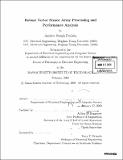Robust vector sensor array processing and performance analysis
Author(s)
Poulsen, Andrew Joseph
DownloadFull printable version (63.64Mb)
Other Contributors
Massachusetts Institute of Technology. Dept. of Electrical Engineering and Computer Science.
Advisor
Arthur B. Baggeroer.
Terms of use
Metadata
Show full item recordAbstract
Acoustic vector sensors, which measure scalar pressure along with particle motion (a vector quantity), feature many advantages over omnidirectional hydrophone sensors. A sizable literature exists on the theory of processing signals for many vector sensor array applications. In practice, however, mismatch (the difference between the assumed and actual system configurations), several noise processes and low sample support can pose significant problems. Processing techniques should be robust to these system imperfections and practical complexities. This thesis presents analytical results which quantify the effect of system mismatch and low sample support on acoustic vector sensor array performance. All arrays are susceptible to perturbations in array element locations; vector sensor arrays, however, are also sensitive to changes in sensor orientation. This is due to the fact that the particle motion vector measurement must be placed in a global reference frame. Gilbert and Morgan (1955) developed a statistical analysis with system mismatch for an array of scalar, omnidirectional elements. This thesis includes a vector sensor extension to their analysis by including sensor orientation perturbations. Theoretical expressions for the mean and variance of the vector sensor array spatial response are derived using a Gaussian perturbation model, with excellent comparisons between theory and simulation. Such analysis leads to insight into theoretical limits of both conventional and adaptive processing in the presence of system imperfections. One noteworthy result is that the vector aspect of the array "dampens" the effect of array mismatch, enabling deeper true nulls. This is accomplished because the variance of the vector sensor array spatial response (due to rotational, positional and filter gain/phase perturbations) decreases in the side lobes, unlike arrays of omnidirectional hydrophones. (cont.) As long as sensor orientation is measured within a reasonable tolerance, the beampattern variance dominates the average side lobe power response. Results from random matrix theory are used to characterize the effect of low sample support on signal detection using a vector sensor array. When using vector sensors, the effects of low sample support potentially increase by a factor of four since each element in a vector sensor array consists of a scalar hydrophone and up to three spatially orthogonal particle motion sensors. Also presented is an analysis of vector sensor array performance in ocean noise given an arbitrary spatial array configuration, sensor orientation and particle motion sensor type (velocity or acceleration). Several different ocean noise models exist, including isotropic noise, directional noise and realistic surface generated noise. Theoretical expressions are derived for array data covariance matrices in these different noise models for arbitrary array configuration and sensor orientation, which can in turn be used with optimal MVDR beamforming weights to analyze array gain. Using Monte Carlo simulations, we present examples of signal, noise and array gain variability as a function of mismatch intensity. Our analysis suggests that vector sensor array gain performance is less sensitive to rotational than to positional perturbations in the regions of interest. Hydrophones and particle motion sensors have very different response and noise characteristics. For instance, particle motion sensors are more sensitive to non acoustic, motion-induced noise than hydrophones. In a towed line array configuration, those sensors orthogonal to the direction of motion are exposed to higher intensities of flow noise at low frequencies than those coincident to the array axis. (cont.) Similarly, different dipole sensors may be exposed to varying degrees of rotational mismatch. Sensors may also rest on the seafloor, creating asymmetries. Recognizing these practical issues, we derive a new adaptive processing method customized to the unique characteristics of vector sensors and robust to mismatch and finite sample support. This new approach involves using multiple white noise gain constraints. During the past couple of decades, stationary vector sensor arrays have been built and tested, demonstrating improved gain and ambiguity lobe attenuation. Up until recently, however, very few towed vector sensor arrays had been built and tested. As such, many of the advantages of vector sensor arrays had only previously been shown in theory and/or with stationary arrays. We present results from sea trials in Monterey Bay, CA (2006) and Dabob Bay, WA (2007) towing a relatively short vector sensor array. Results highlight several of the distinct practical advantages of vector sensor arrays: resolution of spatial ambiguity (e.g., port/starboard and conical ambiguity), the ability to "undersample" an acoustic wave without spatial aliasing, quiet target recovery via clutter reduction, immunity to mismatch, improved array gain and enhanced detection performance.
Description
Thesis (Ph. D.)--Massachusetts Institute of Technology, Dept. of Electrical Engineering and Computer Science, 2009. Includes bibliographical references (p. 179-186).
Date issued
2009Department
Massachusetts Institute of Technology. Department of Electrical Engineering and Computer SciencePublisher
Massachusetts Institute of Technology
Keywords
Electrical Engineering and Computer Science.